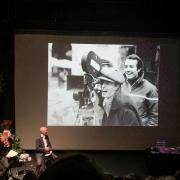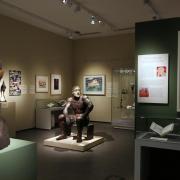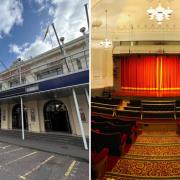Inspired by an oil-filled egg-timer, the lava lamp - which is celebrating its 50th birthday - was one of the great design icons of the Swinging Sixties and was created by a former RAF pilot at his factory in Poole
With its gloopy, trippy, luminous light, the gently bubbling Astro lava lamp will forever be associated with the turn-on, tune-in, drop-out generation of the 1960s.
Organiser of the famed Woodstock Festival, Wavy Gravy, called the lava lamp “Amazing”, adding with breathless enthusiasm that: “It causes the synapses in your brain to loosen up.”
In fact this ultimate addition to any Sixties or early Seventies hippy pad owes its origins to a Dorset-based former World War Two RAF pilot, an extraordinary imagination and that old business trick of being in the right place at the right time.
The man behind the lava lamp – which celebrates its 50th anniversary this year - was the late Edward Craven Walker, a remarkable daredevil, inventor and pioneering naturist who shot the first underwater naked films to squeak past the censor.
Whatever else the dapper Craven (as he was invariably known) was, he was certainly no hippy. Not that he minded. Once aware that everyone from The Beatles to The Grateful Dead were making much of his new invention, he made a public statement: “If you buy my lamp, you won’t need drugs… It is like the cycle of life. It grows, breaks up, falls down and then starts all over again.”
The hippies lapped it up and the endorsement of the counter-culture did Craven no harm at all. The lava lamp was actually inspired by a Heath Robinson style oil-filled egg-timer that Craven spotted in a pub in the New Forest.
Craven set about creating a lamp that worked on roughly the same principal - using heated oil, melted wax and an old orange squash bottle. After many modifications the lava lamp went into production at his factory in Poole in 1963. The company has been based in or around the town ever since.
The first two lava lamps on the market - The Astro and Astro Baby - immediately chimed with the emerging Sixties hipsters but marketing was much tougher in those distant pre-internet days. In fact the original lava lamps were delivered around the country in a rickety old secondhand Post Office van.
Craven’s second wife, Christine Baehr, recalls how exciting life was when the lava lamp suddenly became the must-have accessory for the hip and the happening. No self-respecting follower of fashion would be without one.
It appeared in cult TV programmes like The Prisoner and Doctor Who. It was even deemed an official design classic. Not that the trend-setters had a monopoly. A lava lamp was also featured in the decidedly uncool sit-com George and Mildred.
Down in Poole the Walkers suddenly found themselves at the sharp end of the Swinging Sixties. “Things seemed to move so quickly. It was terribly exciting,” says 69-year-old Christine, who still lives on the Dorset-Hampshire border. “Psychedelia was a long way from our thoughts but it was the height of Beatlemania and one day a shop in Birkenhead phoned and said: ‘We thought you might be interested to know that Ringo Starr has just been in and bought one of your lamps.’
“That was it! We had no experience in marketing or PR but we didn’t waste any time in getting that particular message out. Things went absolutely crazy. We suddenly found ourselves in this bubble which just seemed to keep expanding. It was enormous fun.” That single Beatle endorsement had put their lava lamps well and truly on the map.
Christine met Craven in 1960 when she was still in her teens. They married soon afterwards. She remembers him as a man “full of energy and ideas.” His controversial lifestyle and the notoriety he drew from his naturist films were, says Christine, of little concern: “It didn’t worry him at all because he felt there was nothing to worry about.”
Cressida Granger took over the Poole-based company in the early 1990s and now runs it as Mathmos - a name derived from the seething subterranean lake that featured in the cult 1960s sci-fi movie Barbarella.
She has similar memories of the devil-may-care Craven. She first encountered him when she found a growing demand for lava lamps on a vintage stall she ran at London’s Camden Market. It occurred to her that she might be able to source the lamps direct from the Poole company. After doing a deal with the Walkers she turned the then declining company around and took over the business.
Cressida remembers Craven as a force of nature. “He used to fly helicopters, drive speed-boats and fast cars and once came running into the office shouting: ‘I’ve just bought a fire engine’. He was always inviting me to go in his helicopter. I used to think ‘If you hadn’t crashed so many Jaguars I might actually consider it’. But he was great fun: a very bright and a very unconventional thinker.”
She recalls her initial business meeting with the Walkers at their nudist camp at Matchams just outside Bournemouth but denies claims that she demanded that the couple keep their clothes on for the discussions.
“That wasn’t what happened at all,” she laughs. “It was however suggested that I might like to take my clothes off. Let’s just say that I declined and the meeting went ahead with all us fully clothed...which was a great relief.”
Although lava-style lamps are produced all over the world, Cressida Granger insists that the Mathmos lamps, still finished and filled in Poole, are unique, with the precise contents a closely-guarded secret.
So, I asked, has the secret formula been memorised by a select team and locked in a safe somewhere?
“I’m afraid not,” replied Cressida. “It’s written down and kept in a purple folder!”
To celebrate the lava lamp’s 50th birthday Mathmos has launched a limited edition Astro lava lamp complete with certificate, signed by Christine. The company has also produced a new heritage collection and it has just completed a season of commemorative events at the London Design Festival. This included the unveiling of the world’s largest lava lamp - a 200-litre monster - at the Royal Festival Hall.
But it won’t be the biggest in the world for much longer. At least not if the residents of Soap Lake City in Washington State, USA, get their way; there have been plans afoot for more than a decade to build a 60-foot lava lamp as a tourist attraction. However Mathmos still retains the crown as the $1million dollar plan has yet to find funding...maybe Poole should consider building a giant lava lamp instead?
Discover more at mathmos.com or call 01202 620114



























